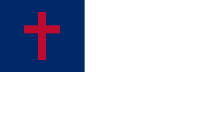Warriors of Christ the King
| Warriors of Christ the King | |
|---|---|
| Guerrilleros de Cristo Rey (Spanish) | |
 | |
| Leader | Mariano Sánchez Covisa |
| Dates of operation | c. 1968 – c. 1980 |
| Motives | Opposition to separatism, communism, secularism and democracy |
| Active regions | |
| Ideology | Traditionalism Spanish nationalism National Catholicism Catholic fundamentalism Neo-fascism[1] |
| Political position | Far-right |
| Notable attacks | Montejurra massacre |
| Status | Inactive |
| Size | Unknown |
| Allies | Batallón Vasco Español Alianza Apostólica Anticomunista Grupos Armados Españoles Acción Nacional Española Antiterrorismo ETA |
| Opponents | Carlist Party Basque National Liberation Movement
|
| Battles and wars | Basque conflict |
The Guerrilleros de Cristo Rey (English: Warriors of Christ the King) was a far-right paramilitary organisation active in the late 1970s in Spain, primarily in the Basque Country and Madrid, but also in Navarre.
History[edit]
The group emerged at a time of factionism within the Carlist movement. Historically Carlism was a traditionalist, legitimist and Catholic movement, supporting a different monarchical line to the one occupying the Spanish throne.
Under the leadership of Carlos Hugo, the group began to support a left-wing, social democrat ideology under the banner of the Carlist Party. This caused large-scale conflict within the movement; many proclaimed his more traditionalist-minded brother, Sixtus Henry, as Carlist regent. Probably the most notable incident involving the group was the Montejurra massacre of 1976, which happened during the annual Carlist pilgrimage to the Montejurra mountain in Navarre. During this attack, two supporters of the Carlos Hugo faction (Ricardo García Pellejero and Aniano Jiménez Santo) were killed. José Luis Marín García Verde and Hermenegildo García Llorente, alleged members of this armed group, were arrested later, but were later released without investigation as Manuel Fraga (Member of Franco's political board) gave direct instructions not to prosecute these murders. The presence of known European Fascist criminals, active in organisations such as Batallón Vasco Español or Alianza Apostólica Anticomunista and Italy in this has led to some speculating a link to the Cold War-era Operation Gladio.
Attacks[edit]
Attacks attributed to the Warriors of Christ the King:[a]
- December 1970: Members of the organisation beat various progressive priests in Ondarroa.[2][3]
- January 1972: The group vandalized the protective bollards outside the Beit Yaacov synagogue in Madrid, spray painting slogans such as "Death to the Jews,” “Synagogue, Judaism, Danger,” “Out with the traitors” and “Long live Catholic unity."[4]
- 2 May 1973: Mariano Sánchez Covisa (leader of the organisation) was arrested for attacking a mass organised by the Movimientos Apostólicos Obreros de Madrid.[5]
- 9 May 1976: During Montejurra massacre members of the organisation were related to the violent actions that took place, along with other terrorist organisations.[6]
- 26 September 1976: The group assassinated 21-year-old student Carlos González Martínez, who was attending a protest of tribute to the last persons executed by Francoist dictatorship in Madrid.[7][8]
- 23 January 1977: Members of the organisation assassinated 19-year-old Arturo Ruiz (member of the Young Red Guard, the youth wing of the Party of Labour of Spain) in Madrid.[9][10]
- 24 August 1978: The group burned the headquarters of the Basque nationalist and anarchist magazine Askatasuna.[11][12]
Notes[edit]
- ^ This list may be incomplete, because many of their attacks were never claimed. Additionally the acronyms GCR and others (Antiterrorismo ETA, Primera Línea de Fuerza Nueva, Batallón Vasco Español, Grupos Armados Españoles, Alianza Apóstolica Anticomunista, and later Grupos Antiterroristas de Liberación and GANE) seem to have been indistinctly used by the same Spanish nationalist networks capriciously.
References[edit]
- ^ Niebel, Ingo (2018). "Himmler's Shadows over Euskal Herria". In Irujo, Xabier; Solé, Queralt (eds.). Nazi Juggernaut in the Basque Country and Catalonia. Center for Basque Studies. University of Nevada, Reno. p. 84.
- ^ Pedro Ontoso (9 April 2014). "Torturas y violencia política en Euskadi". El Correo.
- ^ Iban Gorriti (9 April 2013). "Emiliano de Iturraran y Basabe, un sacerdote tenaz, euskaldun y con ideas firmes". Deia. Archived from the original on 10 September 2014. Retrieved 10 September 2014.
- ^ "Synagogue Desecrated by Right-wing Extremists; Worst in Years". Jewish Telegraphic Agency. 1972-02-03. Retrieved 20 June 2023.
- ^ "El señor Sánchez-Covisa, detenido". Informaciones. 2 May 1973.
- ^ Sánchez Soler 2010, p. 34, 372, 380.
- ^ Pons Prades 1987, p. 320.
- ^ "El Supremo declara víctima del terrorismo a un joven asesinado en 1976". El País. 26 May 2006.
- ^ "Eran cuatro, y el que disparó contra el muchacho fue el más joven". El País. 25 January 1977.
- ^ Juliá, Pradera & Prieto 1996, p. 177.
- ^ "Atentado contra la revista "Askatasuna"". La Vanguardia. 25 August 1978.
- ^ Ceberio, Jesús (25 August 1978). Atentado en Bilbao contra la revista libertaria "Askatasuna".
{{cite book}}:|work=ignored (help)
- Far-right terrorism in Spain
- Paramilitary organisations based in Spain
- 1968 establishments in Spain
- Organizations established in 1968
- 1980 disestablishments in Spain
- Organizations disestablished in 1980
- Anti-communist terrorism
- Anti-communist organizations
- Christian terrorism in Europe
- 20th century in Spain
- Basque history
- Political history of Spain
- Spanish nationalism
